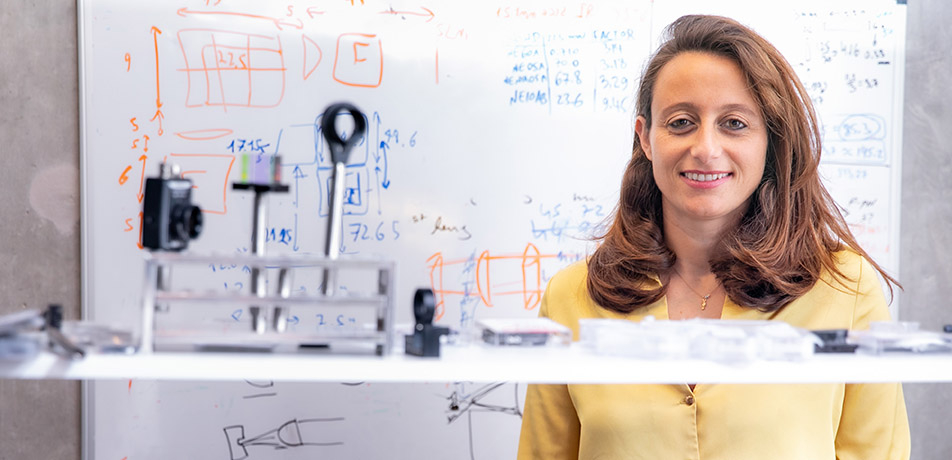Lighting up the world of computation
The promise of a new laser-driven supercomputer, designed by Weizmann alumni
Alumni

Ruti Ben-Shlomi
Computers have been improving at a dizzying rate since the original room-sized machines of the 1940s. Today, our cell phones are millions of times more powerful than the computers used by NASA during the first moon landing. And still, scientists and engineerse are continuing to push the limits of computing capabilities, producing more and more powerful supercomputers and working to make quantum computers a reality.
If computers are already so fast, why this need for more speed?
In traditional computing systems, bits are binary—either on or off, 1 or 0—forcing the computer to try possible answers to a problem one by one until it finds the correct solution. However, as data becomes more and more voluminous and complicated, even the most high-performing computers cannot keep up and are failing to solve many of the modern world’s most complex problems. This class of problems, known as “hard” problems, involves such a huge amount of interdependent information that traditional paradigms do not have the computational firepower required to sustain—let alone analyze—the data.
These “hard” problems are everywhere. Take, for example, the interactive GPS service Waze, which is able to give drivers an alternative route in order to avoid an impending traffic jam. But its ability to recalculate a route for a large quantity of cars and redirect each vehicle in an optimal way so as not to create a second traffic jam is still quite limited.
Scientists are attempting to solve these computing shortcomings by developing quantum systems that use quantum bits, or ‘qubits,’ which can exist as both 1 and 0 simultaneously. This would allow the system to perform many calculations at once and arrive at a solution quicker. However, quantum computers are exceedingly difficult to build, and so far have been plagued with errors that make them fail before any nontrivial program has a chance to run to completion.
The speed of lasers
A year ago, while conducting her PhD research in Prof. Roee Ozeri’s lab in the Department of Physics of Complex Systems, Ruti Ben-Shlomi teamed up with Weizmann alumnus Dr. Chene Tradonsky to launch LightSolver, a company that is building a supercomputer to specifically tackle “hard” problems. The new LightSolver computer will use a traditional computing paradigm that will produce some quantum effects, but instead of using classic binary bits or qubits, they are using optical lasers.
Ruti and her team of eight—half of whom are also Weizmann alumni—believe that by constructing a small device where light-based lasers circulate in free space, the new device will be able to make computations orders of magnitude faster and less prone to error than all other technology alternatives, both traditional and quantum, which use electronics or fibers. In just one watt of lasers, almost 1020 photons exist—that’s 1 followed by 20 zeros—all of which are able to work together and influence each other to perform calculations simultaneously, similar to quantum bits. At the same time, by using a more classical computing paradigm, LightSolver will be able to bypass the noise problems, faults, and loss of quantum coherence inherent to quantum computers.
Not only will LightSolver’s laser computer allow it to make computations at extraordinary speeds, according to Ruti, but it will allow the machine to be smaller (about the size of a desktop computer), cheaper, and more energy efficient than its competitors’ prototypes, which are oftentimes huge in size, or require absolute zero temperatures and ultra-high vacuum conditions.
“Using lasers has so many benefits,” Ruti says. “They require less space than circuitry-based machines, are more precise, and can explore all possible solutions to a problem in parallel similar to the way qubits can. Imagine the massive computational power!”
The team is aiming to develop LightSolver to contain 100 laser bits within the year — an impressive number in a short period of time. In the following year, they hope to increase that number to 1,000 laser bits—a number which currently is only on the future roadmap of quantum computer companies like IBM. Reaching that milestone will also have practical applications and enable the solution of real-world problems involving massive amounts of data, such as city-scale traffic patterns, predicting the stock market, or calculating how to most efficiently fold a protein.
“Using standard computers, this kind of data-crunching is very time-consuming and error-prone,” says Ruti. “LightSolver could solve these problems.”
“Ruti is pioneering an exciting path in the Israeli quantum tech landscape,” Prof. Ozeri says. “LightSolver is part of a very small and dynamic community of startups that are taking ideas from academic quantum physics labs, which until recently were considered crazy games by scientists, and turning them into viable technology.”